
In Gardeners' World 2020 episode 7, Monty Don welcomes us to his garden Longmeadow and to Gardeners' World 2020.
Monty starts the programme by tying back a group 3 Clematis that you need to cut back to the ground in winter or early Spring.
 |
| Copyright BBC.Com |
Now is the time they put on huge growth spurt so to stop the clematis flopping it needs to be tied up ready for the flowering season in the Summer.
The rule with Clematis is that if it flowers before June do not prune it back hard.
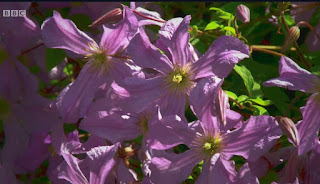 |
| Copyright BBC.Com |
If it flowers after June it is the late flowering kind that need a harder prune.
Monty's Wildlife Garden
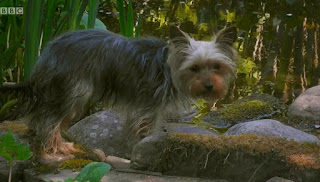 |
| Copyright BBC.Com |
The pond was in the wrong place, so he has moved it and expanded it.
Monty has added a beach at the shallow end of the pond.
A pond needs lots of cover on the inside and outside to make the animals and insects feel secure.
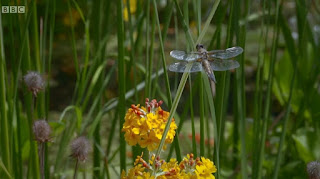 |
| Copyright BBC.Com |
Monty has some plants he has moved from other parts of the garden, starting with Iris Sibrica which flowers in May and June.
Next to be planted is burgundy coloured Ligularia Desdemona, which has yellow flowers and also likes the wet conditions by the pond.
 |  |
The final plant he is putting into the wildlife garden is a Lamium Orvala.
It is a dead nettle with pink flowers that bees love.
It likes woodland shade so he has put it in a shady place that's not too wet.
Cherry Blossom
Last year, Carol Klein visited the National Collection of Fruit at Brogdale in Kent.
 |
| Copyright BBC.Com |
Nothing is more spectacular in Spring than the pink and white Cherry Blossom.
They have 350 different types of Cherry, which form 2 groups, fruit producing or ornamental cherries.
Carol shows us a variety called Prunus Sargenti and talks about the purpose of the flowers being to attract insects to pollinate them.
 |
| Copyright BBC.Com |
The ornamental Cherry tree came to Great Britain from Japan only 100 years ago.
In Japan they have festivals every year to celebrate the blooming of the cherry blossom.
There is more about Japan and the story of the cherry blossom in Monty Don's Japanese Gardens.
 |
| Copyright BBC.Com |
Carol shows us Japans most popular Cherry tree known as Yoshino Cherry Prunus X Yedoensis.
Tai-haku The Great White Cherry is also spoke about at length by Monty and the story of how it was extinct in Japan but discovered in an English garden Nymans by Cherry Ingram or Collingwood Ingram.
Carol's favourites include Prunus Ukon which is a cream colour.
 |
| Copyright BBC.Com |
There is a cherry tree to fit and suit all gardens.
Prunus Surhirtella 'Pendula' is a small tree with drooping flowers.
What sort of root stock the tree is grafted to is important for a small tree it has to have a dwarf root stock.
Cherries love deep loamy soil, and any damaged branches need pruning which needs to be done in late Summer to avoid Silver Leaf a fungal disease.
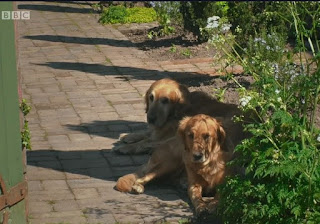 |
| Copyright BBC.Com |
Summer flowering Bulbs
Lilies, Eucomis, Gladioli and Nerines can all be planted now for their summer flowers.
Monty has 2 lots of bulbs to plant that both come from South Africa the first one is Nerines, which have tall stems and mostly pink delicate flowers that come out in September.
 |
| Copyright BBC.Com |
He uses a tall pot with good drainage holes and he adds a crock and gritty peat free compost and adds grit, perlite or sand to the compost.
The bulbs are tall and funnel shaped and need to be planted 2 inches below the soil.
Monty recommends overplanting the pot and he covers in gritty compost.
It loves the sunshine and needs to be watered weekly.
 |
| Copyright BBC.Com |
Next to be planted is Eucomis Bicolor Two-Coloured Pineapple Lily, a punk pineapple this bulb likes plenty of moisture.
The compost if different too and needs less grit, they are planted not so deep and just covered over.
The flowering season is June to October.
Tulips, Dolly tubs and Chickens
Arthur Parkinson comes from Nottingham and is bright Tulip and galvanised container obsessed.
 |
| Copyright BBC.Com |
He has tulips everywhere and calls them 'Flower Prozac.
He loves a Dolly tub and his chickens are happy to eat the grit he adds to his pots.
His front garden is just 20 foot by 8 foot and he has over 500 bulbs planted.
 |
| Copyright BBC.Com |
For a lovely smelling Tulip by his front door he has Tulipa 'Ballerina' and Tulipa 'Brown Sugar'.
For foliage he uses Kale 'Redbor' and baby Cardoons.
He describes them as having 'William Morris Curtains' closing around him.
 |
| Copyright BBC.Com |
Frances' Allotment
Frances says that now more than ever she wants an successful allotment where she can grow what she need to sustain her family.
 |
| Copyright BBC.Com |
She has fruit section with currant bushes, Raspberries, a Pear tree and a Blueberry that has come back to life this year.
Frances is harvesting her Rhubarb which is perennial, it just needs a mulch in the Autumn and a high Nitrogen feed in Spring.
Rhubarb is a good fruit to freeze and makes a great crumble.
She is only sowing seeds for vegetables that she likes.
 |
| Copyright BBC.Com |
On the seed packets there is a colour coded sowing guide, pink for indoors, blue for outdoors, green to plant out and yellow to harvest.
There also guides for depth of seeds and spacing etc.
Frances has already prepared the ground by digging it over and raking and wets the soil first.
 |
| Copyright BBC.Com |
Parsnips are the first to be planted in a shallow drill 30cm apart.
These can be thinned out later and its better to sow more than you think you need.
Frances says she finds it therapeutic to sow seeds that will harvest in the future when hopefully things are better.
Now she is sowing some seeds in trays that wont be ready yet for planting outdoors.
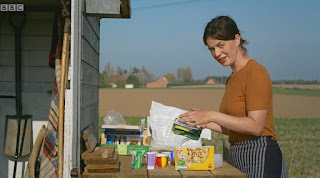 |
| Copyright BBC.Com |
As it is quite difficult to get hold of gardening supplies she is recycling old yogurt pots and butter tubs etc.
Squashes, Courgettes, Beans and sweetcorn can all be sown in tubs now.
Today Frances is sowing 'Wagtail' Sweetcorn a variety she has not tried before in peat free compost in pots that she has made drainage holes in.
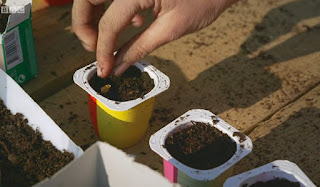 |
| Copyright BBC.Com |
She puts 2 in each pots, waters and puts on sunny window sill they will need watering so they don't dry out.
Chard
Monty's Swiss Chard that he sowed last July and planted outside in August has been a great mainstay in his garden.
 |
| Copyright BBC.Com |
Its great in a pasta cream sauce apparently!
This dry weather is perfect for hoeing, this means you can cut the weeds off and they will dry out and die.
Banana Plant
Monty is taking his Banana plant out of the greenhouse to harden off outside.
 |
| Copyright BBC.Com |
Tender plants that have been overwintered somewhere needs to be brought out gradually and hardened off to stop disease and pest attack.
Monty keeps protection like fleece or hessian in case they need protecting,
Olives
Monty is repotting his olive trees who hate to be cold and wet.
Olives are under threat by the disease Xylella which has decimated Olive trees on the Continent.
The Government has restricted the importation of Olive trees, Rosemary and Lavender.
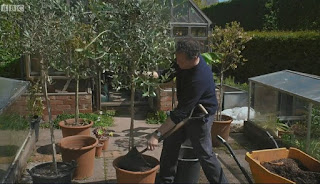 |
| Copyright BBC.Com |
They need repotting every 2 years and the compost needs to be very gritty to be very well draining.
He is using a terracotta pot this time as it drains better.
He teases off the old compost so it has nice fresh compost on the roots.
 |
| Copyright BBC.Com |
He works the compost well to make sure there are no air pockets at the root.
He feeds his olives every fortnight with Liquid seaweed and waters them weekly.
Gladioli
Nick Bailey went to South Africa to the Drakensberg Mountains in search of wild Gladioli in a past series.
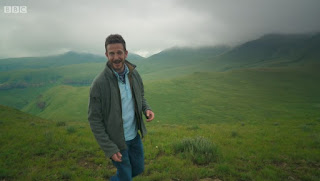 |
| Copyright BBC.Com |
The landscape is spectacular in South Africa and Gladioli grow everywhere.
It comes from the Roman word for sword and is a member of the Iridaceae family.
They have been in Europe since 1739.
The wild species are more delicate than our hybrids.
 |
| Copyright BBC.Com |
He meets with Rod and Rachel Saunders. world renowned Botanists who were tragically killed in 2018 after being kidnapped and robbed.
The filming took place shortly before their tragic deaths.
They talk about their diversity and how they are everywhere in South Africa and the most iconic bulb.
 |  |
| Copyright BBC.Com |
Rob talks about spotting a Gladiolus Symonsii that was last seen in 1960.
It took them 4 years to find. He says how he let out a 'Banshee yell'.
They set out on a plant hunt and find Gladiolus Crassifolus, Ecklonii and Microcarpus that they were luckily to see.
 |
| Copyright BBC.Com |
They are at threat from climate and environmental changes.
The interview ends poignantly with Rod saying 'it's nice to be here'.
Tomatoes
Monty is outside his greenhouse with his 'Costoluto Florentino' plants which were sown in Episode 1 in March.
They can now be potted on to bigger pots as the roots have grown well.
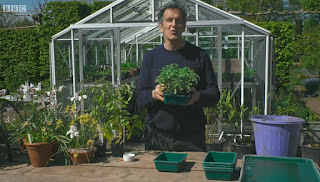 |
| Copyright BBC.Com |
Monty is going to take us through the whole process for people that are new to growing their own.
He has a seed tray but any container will do, which he fills with peat free compost and gives it a shake.
He is planting the well know cherry variety 'Gardener's Delight' as they are readily available.
 |
| Copyright BBC.Com |
He spaces them out using a label after pouring the seeds into his hand.
He presses the seeds down and sprinkles them with compost.
They are then labelled and either soaked in a tray of water or gently watered.
 |
| Copyright BBC.Com |
These need to go somewhere warm and not too sunny as the compost will bake and in 7 - 10 days they should be up.
Angelica Gigas
Monty is planting out the seedlings he has grown, it is one of his favourite with its domed maroon flowers and stems.
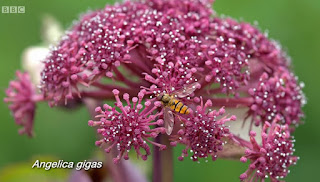 |
| Copyright BBC.Com |
It grows to 5 - 6 feet tall and bees love them.
Viewers Videos
Jade Bowen from Dorset she has a baby plant army in her mini greenhouse including peas and runner beans.
 |  |
| Copyright BBC.com |
She has carrots, tomato plants, parsnips, courgettes, pumpkins, cucumbers and squashes.
In the kitchen there is lettuce, radish and spring onions and she makes her pots from junk mail!
Zach from Bedford has a wildlife pond and has made a frog house.
 |
| Copyright BBC.com |
He dug a whole and put sand it in and covered it with an old birdbath and logs.
Zach has loads of tadpoles in his pond.
Roy Shepherd in Somerset shows us how you can grow plants in milk cartons for all the seedlings he has grown.
 |  |
| Copyright BBC.com |
He makes 'seed boats' and then can then be carried around.
He also puts holes in the lid and uses that as a watering can.
 |
| Copyright BBC.com |
Weed your borders
To keep on top of the fast growing weeds you need to go through your borders searching them out.
Make sure you get all the root if possible, any plants your not sure of just leave to see what they grow into.
Sow Sunflowers
There are so many sunflower varieties so there will be one suitable for your garden whether you want a giant or a subtle coloured one.
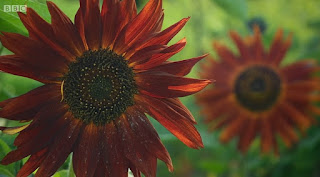 |
| Copyright BBC.com |
Monty is sowing 'Velvet Queen' for the Jewel Garden which is marmalade coloured.
He sows 1 seed per plug and then pot them on later, and planted out at the end of June.
Stake Herbaceous Perennials
Now the time to get the supports in before they get floppy or wind damaged.
You can use canes and string or bought or home made metal supports.
Try to get a natural look.
Pond
Monty ends the show at his other pond admiring his Camassias which gets better every year as the plants grow and spread.
 |
| Copyright BBC.com |
He ends the programme by encouraging us all to get outside into the healing power of our gardens or outside space.
Share this post

No comments:
Post a Comment